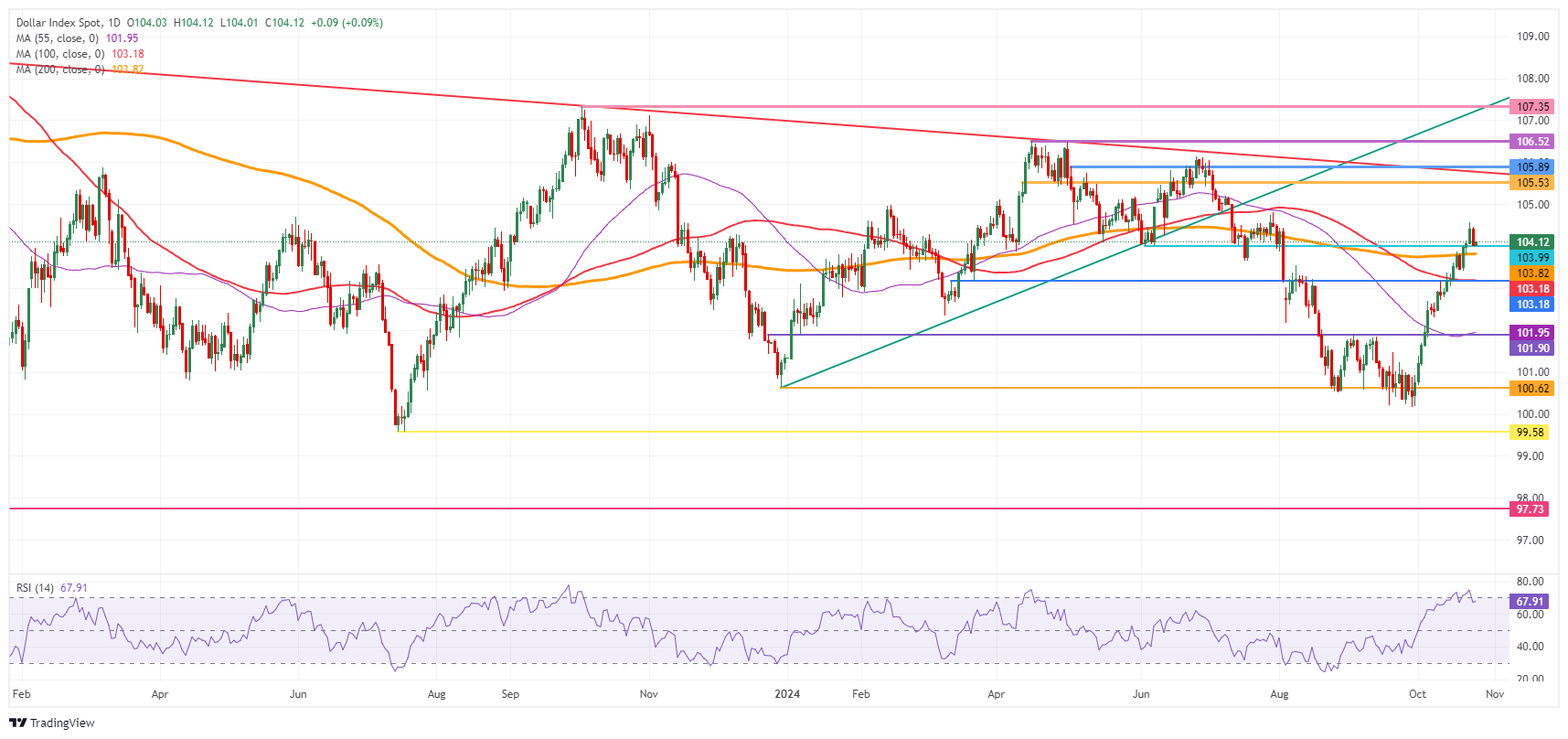- The US Dollar breaks to the downside after trading in a tight range earlier this Friday
- Traders are sending the Greenback lower after disappointing Durable Goods orders data.
- The US Dollar index hovers around 104.00, fails to find support.
The US Dollar (USD) falls lower this Friday after US Durable Goods fell by -0.8%. As such that number was better than expected, though as always the devil is in the detail. The previous 0% got sharply revised down to -0.8%, which means that Durable Goods in the US are contracting for already two months in a row.
The US economic calendar is facing just one last main event this Friday. The University of Michigan will release its final reading for October’s Consumer Sentiment data. Seeing it is the fnal reading, no big changes expected here.
Daily digest market movers: Here comes Durable Goods
- This Friday’s data calendar kicks off at 12:30 GMT with the Durable Goods release for September:
- Durable Goods Orders contracted by 0.8% against the expected 1%. The earlier month got revised down from 0% to -0.8%.
- Durable Goods without Transportation jumped by 0.4%, avoiding the expected contraciton by 0.1%. The previous reading got revised up from 0.5% to 0.6%.
- Closing off this Friday at 14:00 GMT, The University of Michigan will release its final reading for October. Consumer Sentiment is expected to tick up marginally to 69.0 from the preliminary reading of 68.9. The 5-year inflation expectations are expected to remain unchanged at 3%.
- At 15:00 GMT, Federal Reserve Bank of Boston President Susan Collins participates in a conversation about the Fed’s efforts to create an economy that works for everyone at the Mass Black Expo in Boston.
- Equities are welcoming the softer Durable Goods reading and are heading into green numbers for this Friday.
- The CME FedWatch Tool is backing a 25 basis point (bps) rate cut with a 97% probability against a 3% chance of no rate cut for the upcoming Fed meeting on November 7.
- The US 10-year benchmark rate trades at 4.18%, down from the high of 4.24% seen Wednesday.
US Dollar Index Technical Analysis: Watch out for headline risks and more polls on US elections
The rally in the US Dollar Index (DXY) is facing a crucial moment to confirm if it has more room to go. Support at 104.00 is being tested, and the close at the end of the US trading session will be vital. A close above 104.00 could see the DXY rally further towards 105.00 with US presidential election uncertainties picking up steam next week.
The DXY has broken above 104.00 and it is in an empty area that could quickly see 105.00 emerge as the first cap on the upside. Once above that level, watch out for the pivotal 105.53 (April 11 high) and 105.89 (May 2 high). Ultimately, 106.52 (double top from April) or even 107.35 (October 3, 2023, high) could show sharp resistance and selling pressure due to profit taking.
On the downside, the 200-day SMA at 103.81 emerges as a very strong support. Look out for false breaks, and consider waiting for a daily close below that level when reassessing if there will be more downside for the DXY. The next big support is double, with the 100-day SMA at 103.19 and the pivotal 103.18 level (March 12 high). If that level breaks, a big gap lower would open toward the 101.90 support zone, with the 55-day SMA at 101.93.
US Dollar Index: Daily Chart
Central banks FAQs
Central Banks have a key mandate which is making sure that there is price stability in a country or region. Economies are constantly facing inflation or deflation when prices for certain goods and services are fluctuating. Constant rising prices for the same goods means inflation, constant lowered prices for the same goods means deflation. It is the task of the central bank to keep the demand in line by tweaking its policy rate. For the biggest central banks like the US Federal Reserve (Fed), the European Central Bank (ECB) or the Bank of England (BoE), the mandate is to keep inflation close to 2%.
A central bank has one important tool at its disposal to get inflation higher or lower, and that is by tweaking its benchmark policy rate, commonly known as interest rate. On pre-communicated moments, the central bank will issue a statement with its policy rate and provide additional reasoning on why it is either remaining or changing (cutting or hiking) it. Local banks will adjust their savings and lending rates accordingly, which in turn will make it either harder or easier for people to earn on their savings or for companies to take out loans and make investments in their businesses. When the central bank hikes interest rates substantially, this is called monetary tightening. When it is cutting its benchmark rate, it is called monetary easing.
A central bank is often politically independent. Members of the central bank policy board are passing through a series of panels and hearings before being appointed to a policy board seat. Each member in that board often has a certain conviction on how the central bank should control inflation and the subsequent monetary policy. Members that want a very loose monetary policy, with low rates and cheap lending, to boost the economy substantially while being content to see inflation slightly above 2%, are called ‘doves’. Members that rather want to see higher rates to reward savings and want to keep a lit on inflation at all time are called ‘hawks’ and will not rest until inflation is at or just below 2%.
Normally, there is a chairman or president who leads each meeting, needs to create a consensus between the hawks or doves and has his or her final say when it would come down to a vote split to avoid a 50-50 tie on whether the current policy should be adjusted. The chairman will deliver speeches which often can be followed live, where the current monetary stance and outlook is being communicated. A central bank will try to push forward its monetary policy without triggering violent swings in rates, equities, or its currency. All members of the central bank will channel their stance toward the markets in advance of a policy meeting event. A few days before a policy meeting takes place until the new policy has been communicated, members are forbidden to talk publicly. This is called the blackout period.
Information on these pages contains forward-looking statements that involve risks and uncertainties. Markets and instruments profiled on this page are for informational purposes only and should not in any way come across as a recommendation to buy or sell in these assets. You should do your own thorough research before making any investment decisions. FXStreet does not in any way guarantee that this information is free from mistakes, errors, or material misstatements. It also does not guarantee that this information is of a timely nature. Investing in Open Markets involves a great deal of risk, including the loss of all or a portion of your investment, as well as emotional distress. All risks, losses and costs associated with investing, including total loss of principal, are your responsibility. The views and opinions expressed in this article are those of the authors and do not necessarily reflect the official policy or position of FXStreet nor its advertisers. The author will not be held responsible for information that is found at the end of links posted on this page.
If not otherwise explicitly mentioned in the body of the article, at the time of writing, the author has no position in any stock mentioned in this article and no business relationship with any company mentioned. The author has not received compensation for writing this article, other than from FXStreet.
FXStreet and the author do not provide personalized recommendations. The author makes no representations as to the accuracy, completeness, or suitability of this information. FXStreet and the author will not be liable for any errors, omissions or any losses, injuries or damages arising from this information and its display or use. Errors and omissions excepted.
The author and FXStreet are not registered investment advisors and nothing in this article is intended to be investment advice.
Recommended content
Editors’ Picks

Gold retreats after setting new record-high above $3,000
Gold corrects lower and trades below $3,000 after setting a new record-high above this level earlier in the day. Rising US Treasury bond yields and the upbeat market mood seems to be limiting XAU/USD's upside for the time being.

EUR/USD advances toward 1.0900 on renewed USD weakness
EUR/USD gains traction and rises toward 1.0900 following a two-day decline. The improving risk mood makes it difficult for the US Dollar (USD) to find demand and helps the pair push higher. Markets await US consumer sentiment data for March.

GBP/USD rebounds from session lows, stays near 1.2950
GBP/USD recovers toward 1.2950 after falling below 1.2920 with the immediate reaction to the disappointing macroeconomic data releases from the UK in the early European session. The renewed USD weakness amid a positive shift seen in risk sentiment helps the pair hold its ground.

US SEC may declare XRP a 'commodity' as Ripple settlement talks begins
The US SEC is considering declaring XRP as a commodity in the ongoing settlement talks with Ripple Labs. FOX News reports suggest Ethereum's regulatory status remains a key reference for XRP’s litigation verdict.

Week ahead – Central banks in focus amid trade war turmoil
Fed decides on policy amid recession fears. Yen traders lock gaze on BoJ for hike signals. SNB seen cutting interest rates by another 25bps. BoE to stand pat after February’s dovish cut.

The Best brokers to trade EUR/USD
SPONSORED Discover the top brokers for trading EUR/USD in 2025. Our list features brokers with competitive spreads, fast execution, and powerful platforms. Whether you're a beginner or an expert, find the right partner to navigate the dynamic Forex market.
